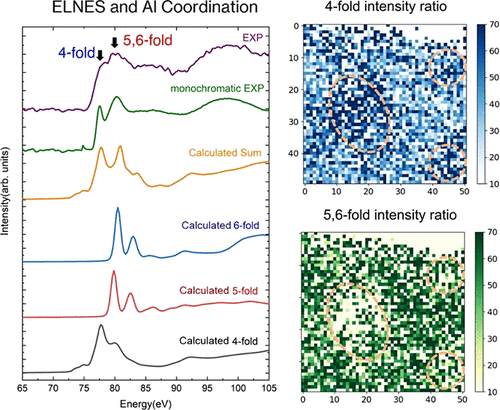当前位置:
X-MOL 学术
›
J. Phys. Chem. Lett.
›
论文详情
Our official English website, www.x-mol.net, welcomes your
feedback! (Note: you will need to create a separate account there.)
Revealing Spatial Distribution of Al-Coordinated Species in a Phase-Separated Aluminosilicate Glass by STEM-EELS
The Journal of Physical Chemistry Letters ( IF 4.8 ) Pub Date : 2020-11-16 , DOI: 10.1021/acs.jpclett.0c02687 Kunyen Liao 1 , Atsunobu Masuno 2 , Ayako Taguchi 3 , Hiroki Moriwake 3 , Hiroyuki Inoue 1 , Teruyasu Mizoguchi 1
The Journal of Physical Chemistry Letters ( IF 4.8 ) Pub Date : 2020-11-16 , DOI: 10.1021/acs.jpclett.0c02687 Kunyen Liao 1 , Atsunobu Masuno 2 , Ayako Taguchi 3 , Hiroki Moriwake 3 , Hiroyuki Inoue 1 , Teruyasu Mizoguchi 1
Affiliation

|
Structure determination of glass remains an important issue in glass science. The electron microscope with its high spatial resolution and versatile functions has been widely applied to observe phase separation and structural heterogeneity in glass. While elemental analysis such as energy dispersive spectroscopy (EDS) and electron energy loss spectroscopy (EELS) may provide local compositional information with nanometer-scale resolution, structural information in a glass network cannot be directly obtained. Here, a novel way to probe local coordination is employed using electron energy loss fine structure (ELNES) in the scanning transmission electron microscope (STEM). The method is demonstrated in a phase-separated aluminosilicate glass with multiple Al-coordinated species. With the support of ab initio calculation, two exciton-like peaks in the Al L2,3-edge at around 77 and 80 eV are attributed to 4-fold and 5,6-fold Al excitations, respectively. Mapping of the relative intensity ratio for two peaks in a phase-separated microstructure reveals a heterogeneous distribution of highly coordinated Al species in real space. The finding is in agreement with previous MD simulation that 5- and 6-fold Al species are favored to form in the Al-rich phase. This work has demonstrated that complex network structure within the phase-separated region can now be studied via STEM-EELS.
中文翻译:

通过STEM-EELS揭示相分离的铝硅酸盐玻璃中铝配位物种的空间分布
玻璃的结构确定仍然是玻璃科学中的重要问题。具有高空间分辨率和多功能功能的电子显微镜已广泛应用于观察玻璃中的相分离和结构异质性。尽管元素分析(例如能量色散光谱(EDS)和电子能量损失光谱(EELS))可以提供具有纳米级分辨率的局部组成信息,但无法直接获得玻璃网络中的结构信息。在此,在扫描透射电子显微镜(STEM)中使用电子能量损失精细结构(ELNES)采用了探测局部配位的新方法。该方法在具有多个Al配位物种的相分离铝硅酸盐玻璃中得到了证明。在从头算的支持下,大约77和80 eV处的2,3-边缘分别归因于4倍和5,6倍Al激发。相分离的微观结构中两个峰的相对强度比的映射揭示了高度配位的Al物种在真实空间中的异质分布。这一发现与先前的MD模拟相一致,即在富Al相中倾向于形成5倍和6倍的Al物种。这项工作表明,现在可以通过STEM-EELS研究相分离区域内的复杂网络结构。
更新日期:2020-11-19
中文翻译:

通过STEM-EELS揭示相分离的铝硅酸盐玻璃中铝配位物种的空间分布
玻璃的结构确定仍然是玻璃科学中的重要问题。具有高空间分辨率和多功能功能的电子显微镜已广泛应用于观察玻璃中的相分离和结构异质性。尽管元素分析(例如能量色散光谱(EDS)和电子能量损失光谱(EELS))可以提供具有纳米级分辨率的局部组成信息,但无法直接获得玻璃网络中的结构信息。在此,在扫描透射电子显微镜(STEM)中使用电子能量损失精细结构(ELNES)采用了探测局部配位的新方法。该方法在具有多个Al配位物种的相分离铝硅酸盐玻璃中得到了证明。在从头算的支持下,大约77和80 eV处的2,3-边缘分别归因于4倍和5,6倍Al激发。相分离的微观结构中两个峰的相对强度比的映射揭示了高度配位的Al物种在真实空间中的异质分布。这一发现与先前的MD模拟相一致,即在富Al相中倾向于形成5倍和6倍的Al物种。这项工作表明,现在可以通过STEM-EELS研究相分离区域内的复杂网络结构。











































 京公网安备 11010802027423号
京公网安备 11010802027423号